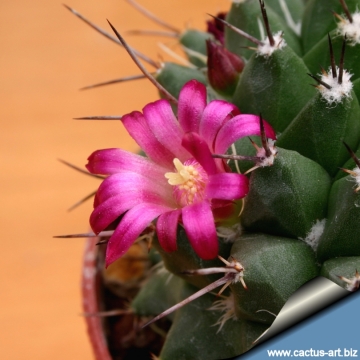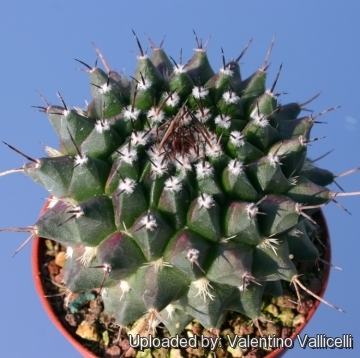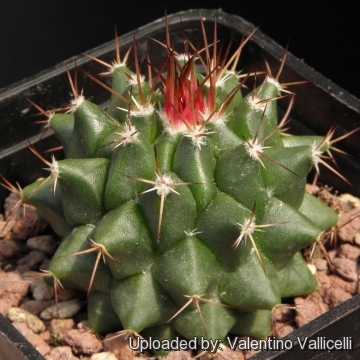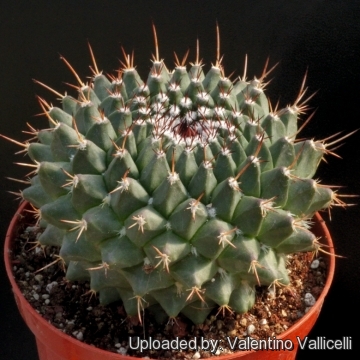Accepted Scientific Name: Mammillaria mystax Mart.
Hort. Reg. Monac. (1829) 127, nomen; et in Nova Acta Phys.-Med. Acad. Caes. Leop.-Carol. Nat. Cur. 16(1): 332. 1832 Mart. & Schrank

Mammillaria erythra f. ruber Photo by: Valentino Vallicelli
REP 879 Tecamayuca, Veracruz, Mexico, 1400m (Now referred to Mammillaria mystax) is an attractive plant with very dark carmine flowers and a characteristic epidermis, which clearly differentiates it from Mammillaria mystax.
Origin and Habitat: The “ruber” form has been collected by Werner Reppenhagen (Field number REP 879) at Tecamayuca, Veracruz, Mexico at an altitude of 1400m
Habitat: Grows on crevices filled with humus, in lava rocks.
Synonyms:
See all synonyms of Mammillaria mystax
back
Accepted name in llifle Database:Mammillaria mystax Mart.Hort. Reg. Monac. (1829) 127, nomen; et in Nova Acta Phys.-Med. Acad. Caes. Leop.-Carol. Nat. Cur. 16(1): 332. 1832Synonymy: 12
back
Description: Mammillaria erythraSN|20663]]SN|20663]] f. ruber (Now referred to Mammillaria mystaxSN|20654]]SN|20654]]) is an attractive plant with very dark carmine flowers and characteristic epidermis that reddens in full sun, which clearly differentiates it from Mammillaria mystaxSN|20654]]SN|20654]]. Furthermore it has a solitary growth and a different body size.
Note: The f. ruber is a "nomen nudum", an undescribed name used commercially to indicate one of the local forms of Mammillaria erythraSN|20663]]SN|20663]], and the two are not distinguishable, if not for the geographical provenance.
Stem: Dull green, that reddens in full sun, globose with an almost a flat-topped appearance, 40-90 mm high and 70-300 mm in diameter. The apex is sunken and wooly. With latex.
Roots: Fibrous.
Tubercles: Pyramidal, firm, 4-angled, keeled, 15-18 mm long and 12-15 mm wide. The axil has white wool and 3-10 short, glassy white with reddish brown tip, straight bristles.
Radial spines: 0-8, needle-like, straight, smooth, whitish to brown, 2-6 mm long.
Central spines: 1-4, the uppermost the longest, needle-like, straight or slightly curving, with thicker base, glassy brown with black tip, up to 50 mm long.
Flowers: Dark carmine, funnel-form, 18-22 mm long and 10-12 mm in diameter.
Fruits: Dark carmine, club-shaped, 10-15 mm long and 3-5 mm wide, it ripens 5 months after flowering.
Seeds: Brown, flattened keeled, 1,2 mm long and 0,8 mm wide. Hilum subbasal.
Blooming season: Mainly in spring (and sometimes other times of year). It doesn't bloom frequently.
Subspecies, varieties, forms and cultivars of plants belonging to the Mammillaria mystax group
- Mammillaria erythra Repp.: has solitary, flattened, stem to 30 cm Ø, with pyramidal, 4-angled tubercles and shorter spines. The dull-green epidermis redden if exposed to sun light. Distribution: Veracruz (near Azumbitla) border with puebla near Acultzingo.
 Mammillaria erythra f. ruber Repp., n.n.: has very dark carmine flowers and characteristic epidermis that reddens in full sun. Furthermore it has a solitary growth and a larger stem to 30 cm in diameter. Distribution: Tecamayuca, Veracruz, Mexico.
Mammillaria erythra f. ruber Repp., n.n.: has very dark carmine flowers and characteristic epidermis that reddens in full sun. Furthermore it has a solitary growth and a larger stem to 30 cm in diameter. Distribution: Tecamayuca, Veracruz, Mexico. Mammillaria mystax Mart.: has flattened stems with neat pyramid-shape tubercle, with age can offset to form clumps. Spines are of variable length, occasionally up to 7 cm long. Distribution: highlands of southern central Mexico, centering in Puebla, Guerrero and Oaxaca.
Mammillaria mystax Mart.: has flattened stems with neat pyramid-shape tubercle, with age can offset to form clumps. Spines are of variable length, occasionally up to 7 cm long. Distribution: highlands of southern central Mexico, centering in Puebla, Guerrero and Oaxaca.- Mammillaria mystax var. huajuapensis (Bravo) Lizen
Bibliography: Major references and further lectures.
1) Robert T. Craig “The Mammillaria handbook: with descriptions, illustrations, and key to the species of the genus Mammillaria of the Cactaceae” E P Publishing, 1945
2) John Pilbeam “Mammillaria The Cactus File Handbook” Cirio Pub. Services, 01/Dec/1999Edward Anderson “The Cactus family” Timber Press, Incorporated, 2001
3) James Cullen, Sabina G. Knees, H. Suzanne Cubey "The European Garden Flora Flowering Plants: A Manual for the Identification of Plants Cultivated in Europe, Both Out-of-Doors and Under Glass" Cambridge University Press, 11/Aug/2011
4) David R Hunt; Nigel P Taylor; Graham Charles; International Cactaceae Systematics Group. "The New Cactus Lexicon" dh books, 2006
5) Arias, S., Valverde, T. & Zavala-Hurtado, A. 2013. Mammillaria mystax. The IUCN Red List of Threatened Species. Version 2014.2. <www.iucnredlist.org>. Downloaded on 15 August 2014.
6) Ulises Guzmán, Salvador Arias, Patricia Dávila, “Catálogo de cactáceas mexicanas”
7) Hans Hecht “BLV-Handbuch der Kakteen” BLV-Verlagsgesellschaft, 1982
 Mammillaria erythra f. ruber Photo by: Cactus Art
Mammillaria erythra f. ruber Photo by: Cactus Art Mammillaria erythra f. ruber Photo by: Valentino Vallicelli
Mammillaria erythra f. ruber Photo by: Valentino Vallicelli Mammillaria erythra f. ruber Photo by: Valentino Vallicelli
Mammillaria erythra f. ruber Photo by: Valentino Vallicelli Mammillaria erythra f. ruber Photo by: Valentino Vallicelli
Mammillaria erythra f. ruber Photo by: Valentino VallicelliCultivation and Propagation: Requires excellent drainage provided by porous cactus soil. We suggest repotting every 2-3 years. Prefers bright light and ample airflow. Outside full sun or afternoon shade, inside it needs bright light, and some direct sun. Water the soil abundantly when it is dry to the touch. Allow soil to drain thoroughly before watering again. Do not water much in the winter (Rot prone). Protect from frost. But it's hardy to -5°C if kept dry. During the beautiful season enrich the soil using a fertilizer rich in potassium and phosphorous, but poor in nitrogen, because this chemical element doesn’t help the development of succulent plants, making them too soft and full of water.
Propagation: Direct sow after last frost as it usually don't braches.














